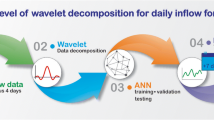Abstract
In the support of all ocean-related activities, it is necessary to predict the actual seawater levels as accurate as possible. The present work aims at forecasting the water levels from 3 to 6 weeks in advance at three locations: Dauphin Island, AL (Gulf of Mexico); Portland, ME (Gulf of Maine); and Cordova, AK (Gulf of Alaska) of divergent oceanic environment along the US coastline using neuro-wavelet technique (NWT) which is a combined approach of wavelet transform (WT) and artificial neural network. For this, time series of water-level anomaly (difference between the observed water level and harmonically predicted tidal level) was used to develop the NWT models at respective stations to predict the water levels for three different lead times from 3 to 6 weeks ahead. For this, hourly observed water levels along with harmonic tides were obtained from the National Oceanic and Atmospheric Administration of USA. The time series of water-level anomaly was decomposed using discrete wavelet transform (DWT) into low (approximate) and high (detail) frequency components. Further, these approximate coefficients were decomposed up to the desired level of decomposition (third and fifth levels) by multiresolution analysis of WT in order to provide more detailed and approximate components which ultimately provides relatively smooth varying amplitude series to develop the NWT models. Thus, the effect of autocorrelation in time series analysis was removed by decorrelating it using WT. Neural networks were trained with these decorrelated approximate and detailed wavelet coefficients. The outputs of networks during testing were reconstructed back using inverse DWT. Network-predicted anomaly was then added to harmonic tidal level to predict the water levels. Performance of NWT models was judged by drawing the water-level plots and other error measures. The NWT models performed reasonably well for all forecasting intervals at all the locations.
Access this chapter
Tax calculation will be finalised at checkout
Purchases are for personal use only
Similar content being viewed by others
References
Nitsure SP, Londhe SN, Khare KC (2014) Prediction of sea water levels using wind information and soft computing techniques. Appl Ocean Res 47:344–351
Dixit PR, Londhe SN, Dandawate YH (2015) Wave forecasting using neuro-wavelet technique. Int J Ocean Clim Syst 5(4):237–248
Dixit PR, Londhe SN, Dandawate YH (2015) Removing prediction lag in wave height forecasting using Neuro-wavelet modeling technique. Ocean Eng 93:74–83
Dixit PR, Londhe SN (2016) Prediction of extreme wave heights using neuro wavelet technique. Appl Ocean Eng 58:241–252
Abrahart RJ, Heppenstall AJ, See LM (2007) Timing error correction procedure applied to neural network rainfall-runoff modeling. Hydrol Sci J 52(3):414–431
De Vos NJ, Rientjest THM (2005) Constraints of artificial neural networks for rainfall-runoff modeling: trade-offs in hydrological state representation and model evaluation. Hydrol Earth Syst Sci (9):111–126
Indian National Centre for Ocean Information Services, Hyderabad, India. http://www.incois.gov.in
Babovic V, Keijzer M (2000) Genetic programming as a model induction engine. J Hydroinform 1(02):35–60
Author information
Authors and Affiliations
Corresponding author
Editor information
Editors and Affiliations
Rights and permissions
Copyright information
© 2019 Springer Nature Singapore Pte Ltd.
About this paper
Cite this paper
Dixit, P., Londhe, S. (2019). Water-Level Forecasting Using Neuro-wavelet Technique. In: Murali, K., Sriram, V., Samad, A., Saha, N. (eds) Proceedings of the Fourth International Conference in Ocean Engineering (ICOE2018). Lecture Notes in Civil Engineering, vol 22. Springer, Singapore. https://doi.org/10.1007/978-981-13-3119-0_49
Download citation
DOI: https://doi.org/10.1007/978-981-13-3119-0_49
Published:
Publisher Name: Springer, Singapore
Print ISBN: 978-981-13-3118-3
Online ISBN: 978-981-13-3119-0
eBook Packages: EngineeringEngineering (R0)




